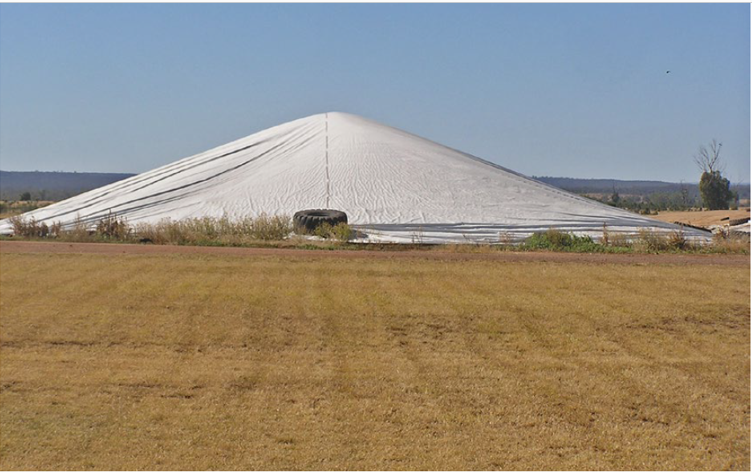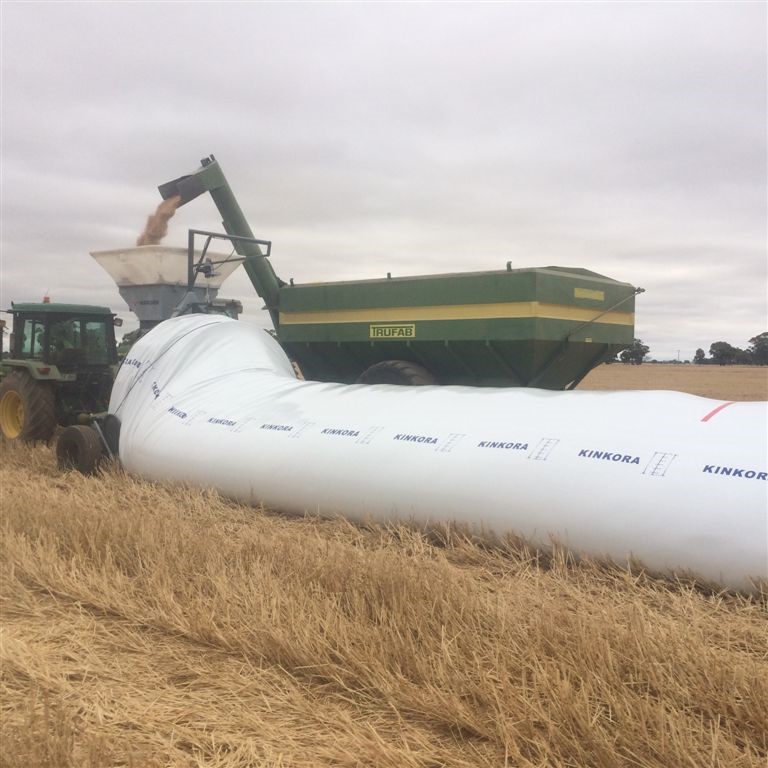Grain storage systems come in a range of shapes and sizes. The design of a grain storage facility should be based on:
- Length of time for storage – temporary or long-term.
- Degree of segregation of different types of grain.
- Identity preservation requirements.
- Expected useful life of the structure.
Silo’s
In general, grain in long term storage should be held cool and dry. Options include smooth wall steel silos, corrugated steel silos bins, concrete silos and underground pits.

Corrugated Silo

Concrete Silo
Silos are high-capacity commercial or industrial structures that are used for permanent grain storage. Besides storage, silos also provide other post-harvest management functions. For example, silos are used as grain collectors and distributional centres.
More importantly, most silos provide initial grain processing functions, which include drying, cleaning, aerating, fumigation, and turning the grains to preserve their condition.
Since silos differ depending on the way of managing grains, each silo structure has its own specific installation and function. However, modern grain silo facilities usually consist of a silo tower and a few storage bins that are equipped with different configurations.
As far as the construction material is concerned, most silos today are built from either steel or concrete. Grain silos also differ in their shape, for instance, rectangular, cylindrical, hexagonal or octagonal. Along with that, silo bins differ in their bottom construction. Accordingly, there are two types of silo bins:
- Flat bottom silo bins
- Hopper bottom silo bins (also called cone bottom silos)
Silos can be built on site or transported fully constructed and ready to stand. The size of fully constructed, transportable silos is limited by road transport regulations in each State. As a general guide, fully constructed silos can be up to 140t capacity. Most smaller (50–70t) cone-bottom silos are generally prefabricated and transported. Cone-bottom silos are self-emptying but are limited to capacities of less than 300t.
Table : Grain bulk densities

Besides that, grain silos can provide different atmospheric conditions for grains.
According to this, we distinguish two types of grain silos:
- Open to the atmosphere on top (also called conventional silos); most commonly used type of silo; usually built from concrete, constructed with an open top or an easy-to-remove cover; the structure minimizes but ensures constant air flow to the storage area; the grains are usually unloaded on the top through the unloading chute
- Oxygen-limiting silos (also called controlled atmosphere silos); the main purpose of the silo is to limit the amount of oxygen in the silo and replace the internal atmosphere with an injection of nitrogen or carbon dioxide; the construction doesn't have any openings and the grains are usually unloaded through the bottom.

A vertical grain silo consists of a number of cylindrical silo bins, usually 10-50m high and 5-50m in diameter. At the receiving point, the grain from the producer is dumped into a hopper or intake well. At the bottom of the well it falls into a loading container and then onto a conveyer belt. The conveyer belt takes the grain to a bucket elevator that pours it in another loading container to be either cleaned or to execute a pre-cleaning action. Thereafter, the grain is transported with a bucket elevator to a bin.
When grain is loaded out, the sluice at the bottom of the silo bin is opened and in most of the silos the grain flows onto a conveyer belt, which runs into a tunnel underneath the row of silo bins. Other types of silos use a conveyer belt or chain conveyer to dump the grain onto a conveyer belt that runs between the two rows of bins.
Click here to view a video that explains a concrete silo construction.
Ground Dumps
An uncovered pile of grain is the cheapest form of temporary grain storage, but risks damage by water, insects, birds, animals and moulds. Grain should be moved from this type of dump as quickly as possible to minimise damage.
The dump site should be higher than the surrounding area, well-drained, well above the water table and formed with a slight slope away from the centre of the site to prevent water damage at the base of the grain pile. Water must be able to drain away freely from the base of the pile.
The site should be graded and sticks, and rocks removed before being hard packed. A hard-packed base helps drainage, provides a compact durable base for operation of filling and emptying machines and for minimising spoilage. A long fall slope of 1:200 to 1:300 (0.3%–0.5%) and a cross fall slope of 1:50 (2%) are necessary for drainage.
The pile should be built uniformly to achieve a maximum grain surface slope (angle of repose). This may be accomplished by keeping the drop distance from the grain elevator to the pile at a minimum. The maximum angle of repose and pile height occurs when grain rolls down the side of the pile.
The surface should be trimmed to produce a smooth, peaked profile - without hills and troughs that will collect rainwater and encourage sprouting and mould growth. A temporary fence around the pile helps to keep out people and animals.
Quality can deteriorate rapidly in uncovered grain piles. Grain temperature and moisture content should be checked at several locations every two or three weeks.

Grain dump
Grain Bunkers
Bunkers are ground dumps covered with protective sheeting. A waterproof plastic lining laid across the floor and walls of the pad will prevent moisture entering from below and contamination by soil.
Pad or bunker storage requires careful site preparation, labour for handling large tarp covers and machinery to move grain on and off the grain pile.
A pad should preferably be orientated so that the closed end faces into the prevailing wind to reduce problems in handling the cover sheets.
The site should be graded with a floor slope of at least 1 in 200 towards the open end, with sticks and rocks removed. A hard-packed base assists drainage provides a compact durable base for operation of filling and emptying machines and accessibility even when wet.
A drainage area around the pad is essential to divert run-off from the protective sheeting.
Effective treatment of insect infestation is difficult in bunkers, as fumigation relies on a sealed gas-tight storage.
The height to which handling equipment can stack grain, the retaining wall height and the angle of repose of the grain will determine the width of the bunker.

Grain Bunker
Retaining Walls Of Grain Bunkers
The capacity of a pad, or bunker, storage facility is increased with the use of retaining walls. These are usually arranged in a U-shape around three edges of the pad site, with an open end for access when filling or emptying.
Retaining walls may be formed from earth or concrete pre-cast or cast in-situ and should be designed and constructed to support the force of the grain exerted on the wall.
Earth walls can be formed using soil from the area immediately outside of the pad perimeter. This creates a channel around the pad, which can be used to drain run-off from the protective sheeting. The soil should be compacted during formation of the walls. Earth walls are typically about 0.5m high and 1.5m wide at the base, with a 45° side slope. Walls higher than 0.5m will need to be designed and constructed to ensure slope stability.
Lining And Cover Sheeting Of Grain Bunkers
The protective cover sheet should be gas-tight to allow fumigation and should resist water penetration, puncturing and UV breakdown.
Pads are best covered with a single piece of prefabricated cover, as joining methods require specialised techniques and equipment.
Materials include woven polyethylene or PVC-coated polyester. Woven polyethylene is cheaper, lighter, more easily handled and depending on grain quality and its admixture content. The grain coefficients can be used for calculating volume of grain when piled at a natural angle of repose will last for several seasons if handled carefully - but may not be as durable as PVC covers. Floors are commonly lined with woven polyethylene or black plastic film.
The cover and floor liner sheets must be sealed to exclude insects, rodents and water and allow effective fumigation. A camber in the surface material around the storage will drain water away.
Sheets can be sealed simply by burying the floor liner and cover in a backfilled trench about 250mm deep at the base of the earth walls.
Once buried, the remaining edge of the sheets should be folded back over the soil backfill to minimise erosion of the backfill.
The cover should be ballasted, or tied down, to prevent damage due to billowing and flapping in the wind. Avoid using objects with sharp projections that could puncture the cover. Place wear patches under ropes or ballast objects to minimise abrasion due to wind movement. The cover should be examined periodically for perforations from animals, birds, rodents, wear points, wind or vandalism. Any damage should be repaired.
Click here to view a video that explains bunker design.
Grain Bags
Seamless grain bags generally range from 40-90m in length and have a 100-300t capacity, depending on bag size, the type of grain and how much the bag is stretched during filling. These are best used only for a few months to store grain. They are not suitable for canola or high value legumes.
After the bag is sealed, the moisture content and temperature of the enclosed grain interact to produce carbon dioxide and deplete oxygen. These conditions suppress any fungi or insects and maintain quality. However, a moisture content greater than 12.5% may spoil grain quality and increases the risk of grain swelling and splitting the bag.
Aeration cooling is not yet proven with grain bags.
Grain bags must be installed on a well-prepared site and away from bird habitats, including trees and water sources. Site preparation as outlined for pad storage should be followed. An elevated, well-drained pad provides optimal results — with no rocks that can tear the grain bags as they are being filled and unloaded. Grain bags can be used only once, as they are usually irreparably damaged when being emptied. Care must be taken in disposing of the used bag material.

Silo Bag
Click here to view a video that explains grain bags.
Other Storage Places At Silo Complexes
Different types of stock are stored at the following places at a silo complex:
- Bins and sheds for grain products.
- Special locked storeroom for Dangerous Chemical Substances (DCS).
- Special air ventilated and locked storage places for diesel and other explosive liquids.
- Separate storeroom for consumables (yarn, tarpaulins, stack-poles, etc.).
- Secure storage places and/or cabinets for hand tools and equipment.
The storage places will also be separate for bulk and bagged grain, whether it is grit or chaff, and depending on the quality/moisture content of the grain.